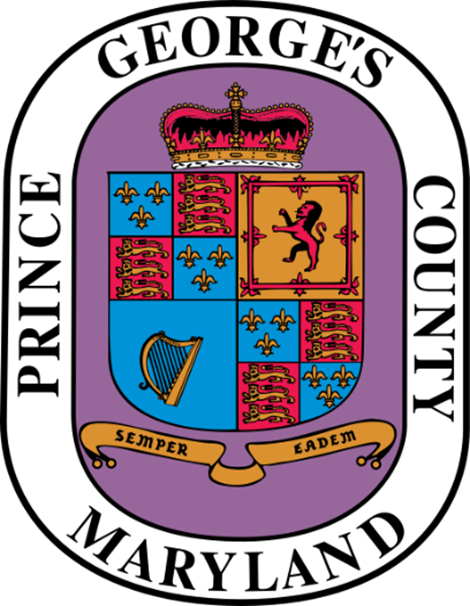
Prince Georges County, Maryland was named after Prince George of Denmark, husband of Queen Anne of Great Britain. Prince George’s County is a county in the state of Maryland, bordering the eastern portion of Washington, D.C. As of the 2022 US Census, the population was 987,957, making it the second-most populous county in Maryland. Its county seat is Upper Marlboro.
In 1791, portions of Prince George’s County, along with portions of Montgomery County, Maryland, as well as the parts of Alexandria, Virginia were ceded to form the newly created Capital of the United States, the District of Columbia. The Alexandria portion was later returned to Virginia.
County Seal
The seal of the county is an oval shaped filled in purple with a thin black inner border and a thicker white outer border. Most of the body of the seal is comprised of a full achievement of arms. Printed in the outer border is “PRINCE GEORGE’S COUNTY MARYLAND. The blazon for the achievement within the seal is as follows:
Quarterly In the first and fourth the arms of France quartering the arms of Plantagenet England; In the second, the arms of Scotland; in the third, the arms of Ireland. In ensign, the St. Edward’s Crown
Motto: SEMPER EADEM
The arms are broken in to four equal sections. This is known as a quartering. The top left quarter is called the “first”, the top right is the “second, the bottom left is the “third”, and the bottom right is the “fourth”.
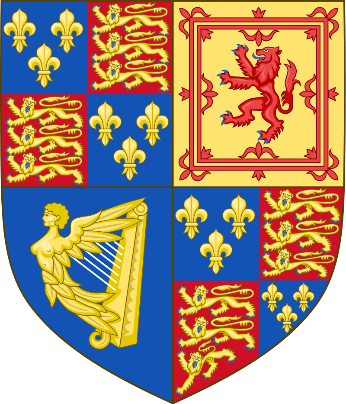
The first and fourth quarters of these arms display the same image. That image is also described as “quarterly”. Officially blazoned as “Quarterly, first and fourth azure three fleur-de-lis Or, second and third gules three lions passant guardant in pale Or armed and langued azure”. This is the royal banner of Queen Anne. It combines the arms of France and the Plantagenet lions of England. In plain-speak, the arms of France are described as three gold fleurs-de-lis on a blue background. “Or” is the Norman term for gold/yellow and “azure” means blue. The display in the second and third are the three lions of England. This was originally the banner of the Plantagenets. These are three gold (Or) lions depicted in profile, head facing towards the viewer (guardant) represented as walking, with the right front foot and tail raised (passant), arranged in a row from top to bottom (in pale), displaying blue (azure) claws and tongues (langued), on a red (gules) background. In heraldry, the attitude, or position of most items on the field, is usually right to left.
In the second quarter of the overall arms is the banner of Scotland. It is blazoned as “Or, a lion rampant Gules armed and langued Azure within a double tressure flory counter-flory Gules.” This is translated as: a red (Gules) lion standing on one hind foot with its forefeet in the air facing the left side, with right hind foot and tail raised (rampant), displaying blue claws and tongue (armed and langued azure) within a red (Gules) double border of fleurs-de-lis alternately pointing in and out (double tressure flory counter-flory), with an overall gold (Or) background.
In the third quarter, the arms of Ireland are represented as “Azure a harp Or, stringed Argent”. This is translated a gold (Or) harp with silver/white strings on a blue (Azure) background.
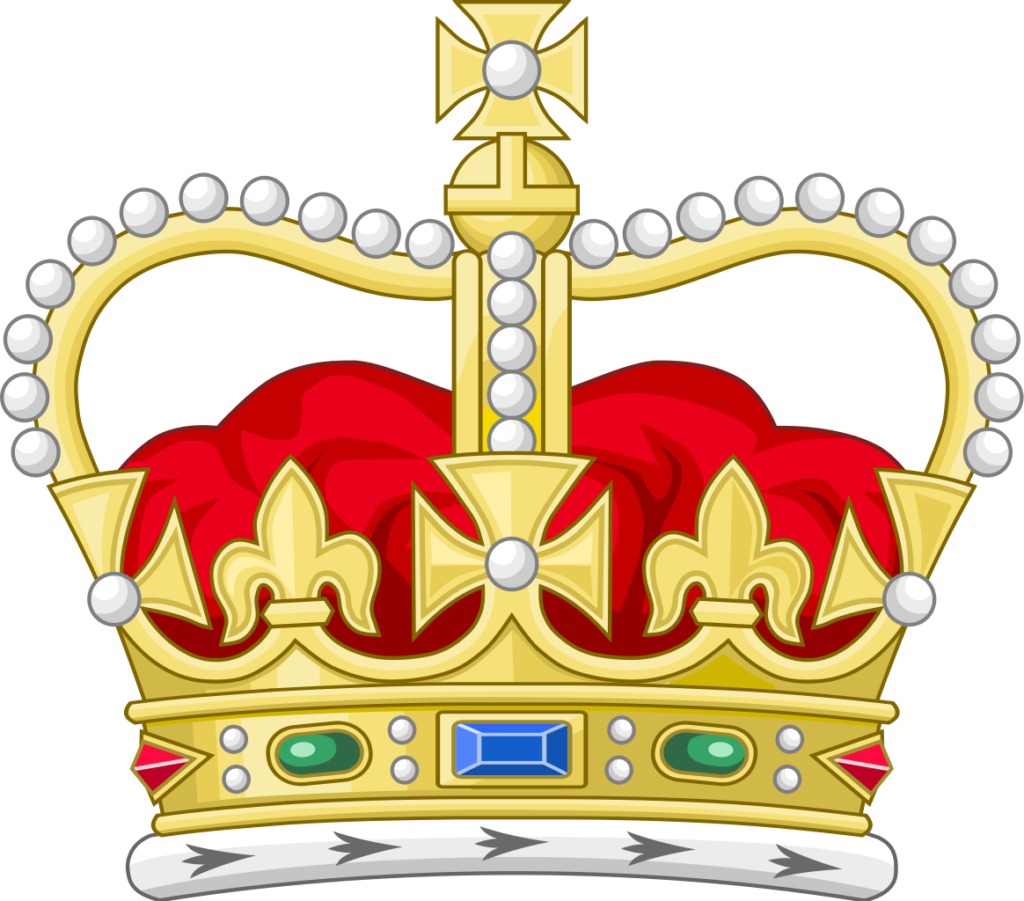
The St. Edward’s crown is placed on top of the shield. This is known as “in ensign”. The heraldic depiction of St. Edward’s Crown is described a jeweled base, or circlet, with three crosses whose arms are narrow at the center and flared to a straight-line shape curving edges (Cross-Pattee) alternating with two fleurs-de-lis (a single fleur-de-lis is paced between two end crosses and the center cross), above which are two semi-circular arches surmounted by a cross. In the center is a velvet cap with an ermine border. Interestingly enough, King Charles III recvently selected a Tudor Crown for use in his seals and insignia. This is in contrast to the St. Edwards Crown that was in use by Queen Elizabeth II.
The banner below the grand quarters depicts the county motto, “SEMPER EADEM,” meaning “Ever the Same.” This motto was used by Queen Anne’s arms as well.
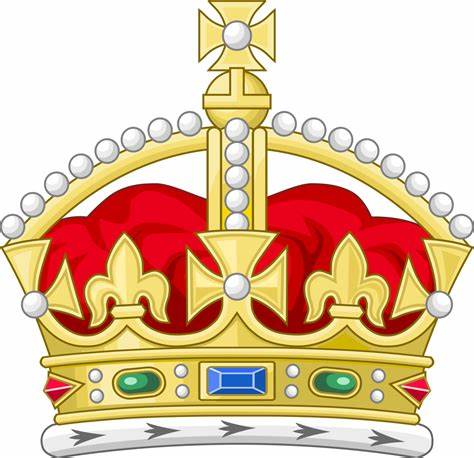
The images on the county seal represent the English heritage of the county. Each quarter of the shield is meant to represent the different kingdoms of Great Britain during the time of Queen Anne. The, while the words “Prince George’s County Maryland” are self-explanatory.
Prince George of Denmark
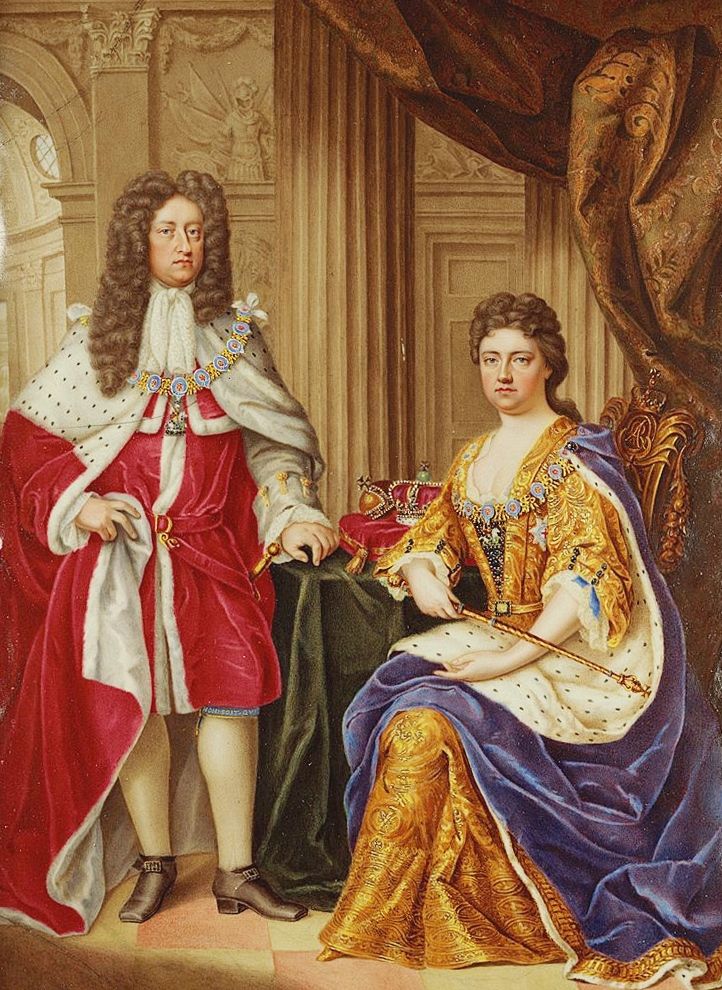
Prince George was the second son of Frederick III of Denmark. He married Princess Anne in 1683 and became her consort during her reign as queen from 1702 until his death in 1708. He paid homage to his wife as his sovereign during her coronation, being the first husband of a reigning queen to pay homage to the sovereign. As consort, Prince George was not politically ambitious. His primary concern was to be loyal to his wife, emotionally and politically. Prince George was devoted to his wife as she suffered numerous unsuccessful pregnancies. By 1700 she had been pregnant at least 17 times, but only five children were born alive. Only her son, William, duke of Gloucester, born in July 1689, survived beyond his third year. William died when he was 11, only a few months after the Queen’s last pregnancy which ended in stillbirth. These constant losses plunged the couple into intense shared grief, drawing them closer together. They enjoyed a reputation as a devoted and, unusually among royalty of that period, faithful couple. His death of severe asthma left the queen devastated. James Brydges, Duke of Chandos, described her grief by saying “His death has flung the Queen into an unspeakable grief. She never left him till he was dead but continued kissing him the moment the breath went out of his body”.
Prince George’s County
Prince George’s County has a rich and vibrant history. From agriculture to industry, school life to religious life, trolleys, trains, and tobacco, the people of this area share a distinctive regional heritage and a great pride in the communities they have built. With numerous recognized historic sites, Prince George’s County boasts, among others, Mount Calvert, the only structure remaining at the site of the first county seat; Melwood Park and the Magruder House, both visited by George Washington; and His Lordship’s Kindness, a Georgian mansion named in recognition of Lord Baltimore’s generosity for the gift of the original land grant.

Other historic buildings were not elegant manors, but functional public facilities. The College Park Airport holds the record as the oldest continuously operating airport in the world, and the Surratt House played a role in the assassination plot of Abraham Lincoln. Modern day Prince George’s County is home to the National Harbor, the Gaylord National Resort, MGM National Harbor, The Capital Wheel, NASA’s Goddard Space Flight Center, FedEx Field and the Washington Commanders, Joint Base Andrews and the President’s Air Force One aircraft, the University of Maryland, Bowie State University, Merkle Wildlife Sanctuary, National Agricultural Library, National Archives at College Park, Rosecroft Raceway, and the USDA Agricultural Research Center.
References
Bryant, K. D., & Schneider, D. (1999, December 12). Prince George’s County, Maryland. Arcadia Publishing.
Ferguson, J. (n.d.). Prince George’s County, Maryland: History and Information. Copyright 2004-2022 Joseph L Ferguson (eRD) – All Rights Reserved. Retrieved September 29, 2022, from https://www.ereferencedesk.com/resources/counties/maryland/prince-georges.html
Historic Royal Places (n.d) Queen Anne: The real story of a forgotten Queen who changed Britain. Retrieved September 29, 2022, from https://www.hrp.org.uk/kensington-palace/history-and-stories/queen-anne/#gs.dgedcc
National Register Properties in Maryland. (n.d.). Retrieved September 29, 2022, from https://mht.maryland.gov/nr/NRDetail.aspx?NRID=40
Prince George’s County History (n.d) Fascinating Facts. Retrieved September 30, 2022, from https://www.experienceprincegeorges.com/explore/history-fascinating-facts/
REAGLES. (2021, May 6). The First British Royal Consort: Prince George of Denmark, duke of Cumberland. The History of Parliament. Retrieved September 29, 2022, from https://thehistoryofparliament.wordpress.com/2021/05/06/the-first-british-royal-consort-prince-george-of-denmark-duke-of-cumberland/ Virta, Alan, (1996) A County With Rich History: Prince George’s County History. Prince George’s History Page. Retrieved September 29, 2022, from https://www.pghistory.org/PG/PG300/history.html